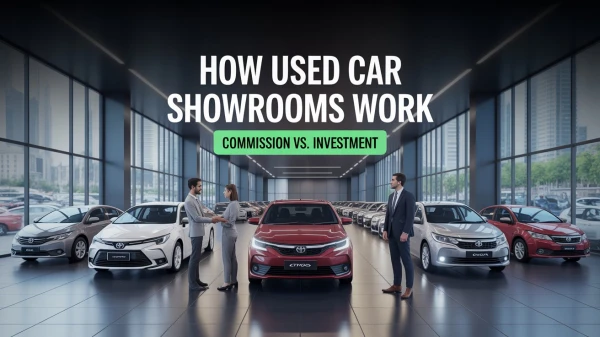
- Admin
- Aug 23, 2025
- Buying Guides
How it Works: Commission vs. Investment in Used Car Showrooms
When it comes to the automobile industry, used car showrooms have carved out a significant niche. With more customers turning to used car dealers for affordable and reliable vehicles, understanding how these businesses operate is crucial. At the heart of their operations are two primary models: commission-based car dealing and investment-based car dealing.
This blog explores how these models work, how they affect both dealers and customers, and why it matters if you’re buying or planning to invest in a dealership.
The Role of Used Car Showrooms
Used car showrooms facilitate the interface between car sellers and car buyers. In contrast to their counterparts in the new car business, they have no direct agreements with the manufacturers. They instead procure the inventory in the form of trade-ins, auctions, or direct purchase by individuals. These cars are checked, repaired, and set in showrooms to be sold.
The effectiveness of any showroom can be determined by two factors: the way it funds its activities (investment) and its commission-based salespersons (sales).
Investment-Based Car Dealing
Investment-based model involves concentration on the development of the business infrastructure and financing inventory. It needs major capital investment in the front end, and it results in the management of the business and multiple sources of income.
Inventory Financing
Virtually all dealers employ a special credit facility, called floor planning, to equip their showrooms. This enables them to roll out a vast selection of automobiles without paying them the full money in advance. The quicker the cars are sold, the cheaper the financing expenses are.
Initial and Running Costs
The amount of investment required to start a used car showroom is significant. It can be expensive to lease a facility or build one, to obtain licenses, insurance, market, and stock early inventory.
Profit Margins
Margins in used car dealing are high, averaging 10-15 percent. Although this does not sound very large, volume sales and a variety of ways to generate revenue have a positive impact on overall profits.
Other Sources of Revenue
Besides the car sales, showrooms can make money by having a service department, extended warranties, accessories, and certifications. In other instances, after-sales services such as repair and maintenance dominate nearly 50 percent of the profit made by a dealer.
Long-Term Growth
Investment will guarantee that the dealership has facilities, cars, and capabilities to run without obstacles. Strategic investing dealers are also in a position to expand, scale up, and have multiple that and diversify into financing and servicing with higher returns.
The investment-based approach, in short, is applicable in creating the foundation and long-term stability of the dealership.
Commission-Based Car Dealing
The commission-based model is based on trying to drive interest in sales staff to sell cars and services. Rather than concentrating on infrastructure, this model compensates individuals based on their performance, and this assists the company in creating a stable cash flow.
Sales Commissions
Salespeople usually earn a percentage of the profit made on each unit of the vehicle in which they work. This may consist of 20 to 40 percent of the gross profit on sale.
Finance and Add-Ons Commission
Commission is not restricted to the price of a car. Sales personnel also make money out of financing activities, insurance, warranties, and accessories. A percentage of this on add-ons can make quite a lot of your earnings per sale.
Tiered Structures
Tier systems of commissions are applied in many dealerships. The greater the number of cars that a salesperson sells, the bigger the commission percentage. This forms healthy competition and volume sales.
Bonuses and Incentives
To ensure morale remains high, the dealerships will add bonuses, targets, or mini payments on low-profit sales. They make sure that the staff will stay motivated despite small margins.
Why It Works
Commission-based systems make the sales and the business interests converge. The quicker the cars leave the lot, the better it is for the dealer and the salesperson.
The commission structure of car dealing maintains the sales engine on one hand, with the investment structure providing the fuel and infrastructure.
Commission vs. Investment: A Comparison
Both approaches have unique strengths, and most successful car dealers use a combination of both.
| Model | Focus | Benefits |
| Investment-Based | Capital, infrastructure, inventory | Provides stability, scalability, and multiple revenue channels |
| Commission-Based | Sales staff incentives, performance | Ensures consistent sales, motivates staff, and drives upselling |
Together, they create a balanced ecosystem where the dealership can thrive financially while keeping the sales team motivated.
What This Means for Customers
Getting to know how used car dealers work helps one make a better choice
Financing Markups
Financing dealers are subject to profits. Loan customers are advised to shop among the various loan providers before tying down.
Add-On Products
Upsells are usually extended warranties, insurance, and accessories. Not all of them can be useful; however, before accepting a deal, a buyer should consider what he or she actually needs.
Service and Maintenance
Dealers can come up with enticing car prices and recover the loss in terms of service prices. Before customers acquire a product, they ought to consider the long-term maintenance costs.
Sales Pressure
Sales personnel operate on a commission basis, and so they might urge extras. Knowing where you need the services you are buying will prevent unnecessary extras.
With this knowledge of the tricks, the customer can appeal better in negotiations and feel safer about buying such a used car
Why Dealers Use Both Models
In the case of used car showrooms, it is important to mix both models. The investment-based strategy gives the framework and economic formulation, and the commission-based strategy guarantees movement of the cars with the salesmen being motivated.
Unless there is investment, a dealer cannot sustain the inventory level or facility. Cars may not sell without commissions. Collectively, they would result in a win-win business model for both the dealership and the consumer.
Conclusion
The world of used car showrooms is built on two fundamental strategies: commission-based car dealing and investment-based car dealing. Investment ensures that the showroom has the vehicles, financing, and infrastructure to operate, while commission ensures that sales staff remain driven to move cars quickly and maximize profits.
Knowing these models is empowering to customers. It exposes the reason behind dealers charging their cars at prices they charge, the rationale behind the offers of financing and add-ons, as well as the tendency of salespeople to close a sale.
SpotMV works to change the old car-buying experience into a more transparent and customer-oriented process. By uniting car dealers and buyers by filling the meager information gap between the two parties and the marketplace, we facilitate easier transactions between the two parties and increase the levels of trust in the market.


Comments